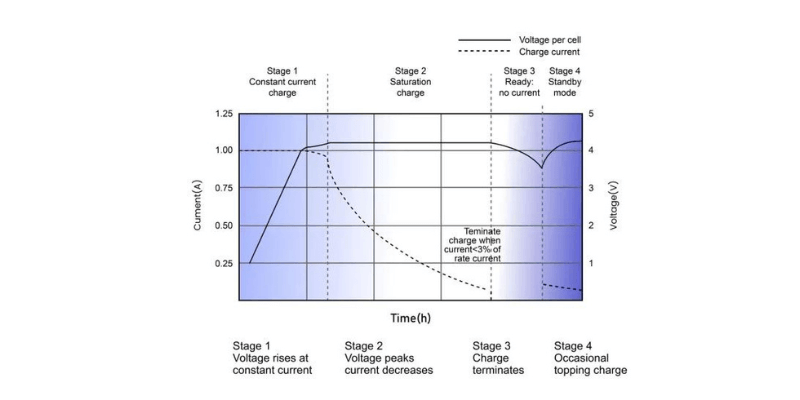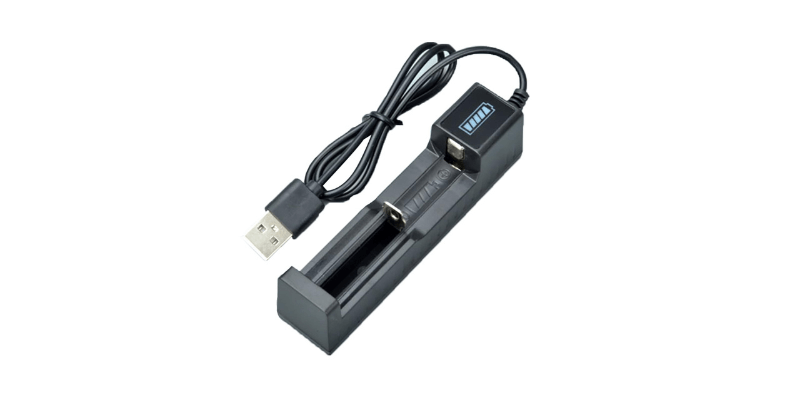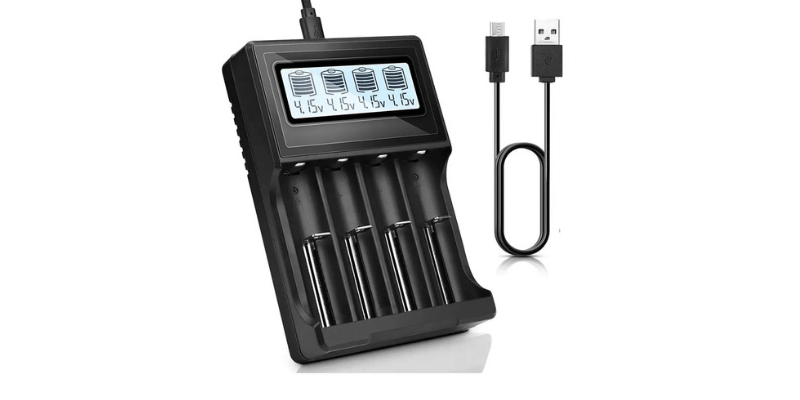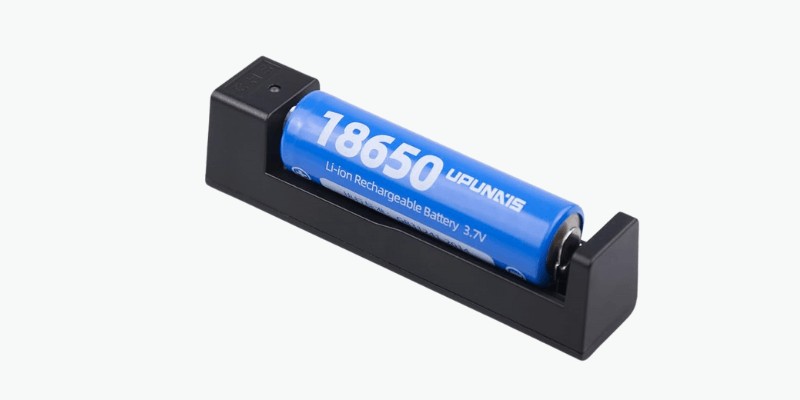تعلم أفضل الممارسات لشحن الخاص بك 18650 البطارية في هذا الدليل. فهم مراحل الشحن ، واختر الشاحن الصحيح ، واستكشف الاستراتيجيات لتعزيز طول طول وسلامة بطارياتك 18650. تبادل المبادئ الأساسية للشحن الفعال لزيادة إمكانات بطارية 18650 إلى الحد الأقصى.
18650 مراحل شحن البطارية
تشمل مراحل شحن البطارية 18650 مراحل التيار الثابت (CC) والمراحل الثابتة للجهد (CV). لمنع الإفراط في الشحن ، افصل البطارية بعد مرحلة الجهد الثابت. يمكن أن تحافظ الرسوم الدورية الصغيرة على طاقتها الكاملة. يوضح الرسم البياني أدناه عملية الشحن ، مع مراحل مختلفة تمت مناقشتها.

تيار ثابت
أثناء الشحن المستمر الحالي ، يمكن أن يكون خلايا خلايا 18650 وتقبل أكبر قدر من التيار ، ولكن التيار المفرط يمكن أن يكون خطيرًا. ابق ضمن الحد المحدد بواسطة ورقة البيانات. عادة ما يتم تعريف الشحن القياسي على أنه 0.5 درجة مئوية (نصف سعة البطارية). بالنسبة لخلية 2500 مللي أمبير في الساعة ، هذا يعني حدوث شحن قياسي يبلغ 1250 مللي أمبير.
الجهد الثابت
يتم شحن خلية البطارية 18650 في الغالب عندما يصل الجهد إلى 4.1 فولت أو 4.2 فولت ، وفي هذه النقطة يتناقص التيار الذي يدخل البطارية تدريجياً.
إنهاء الشحن
يجب أن ينتهي الشحن عندما ينخفض الحالي أسفل قيمة ورقة البيانات. افصل البطارية عن الشاحن مرة واحدة مشحونة بالكامل لمنع الإفراط في الشحن والتلف.
18650 أنواع شاحن البطارية
شواحن أحادية البصر
تعتبر أجهزة الشحن المفردة مثالية للمستخدمين الأفراد الذين يحتاجون إلى شحن بطارية واحدة في وقت واحد. على الرغم من أنها تفتقر إلى الكفاءة المتعددة ، إلا أنها تتضمن عادة ميزات السلامة الأساسية وقابلية النقل. قد تضم النماذج المتقدمة شاشات LCD لعرض حالة الشحن أو قراءات الجهد.

شحنات متعددة
تم تصميم هذه الشواحن ، المتوفرة في تكوينات مزدوجة إلى ثمانية أعمدة ، للمستخدمين الذين يديرون بطاريات متعددة. تتميز بعض الطرز بفتحات شحن مستقلة مع مراقبة التقدم الفردية ، مما يوفر للمستخدمين تحكمًا أكبر وكفاءة.
شواحن ذكية
توفر أجهزة الشحن الذكية إعدادات التيار والجهد القابل للتعديل للشحن الدقيق. وهي مزودة بميزات أمان مثل حماية الشحن الزائد ، والوقاية من الدائرة القصيرة ، وحماية القطبية العكسية.
قد توفر النماذج المتقدمة أيضًا تكييف البطارية أو وظائف تشخيصية لضمان الصحة المثلى.
أجهزة شحن سريعة
تستخدم أجهزة الشحن هذه التقنيات مثل Charge Charge أو توصيل الطاقة USB لتقليل أوقات الشحن بشكل كبير. ومع ذلك ، يجب أن يكون المستخدمون حذرين بشأن التأثيرات المحتملة على عمر البطارية والصحة بسبب زيادة الحرارة من الشحن بشكل أسرع.
شواحن USB
توفر شواحن USB المرونة والتنقل لشحن حزم بطارية 18650 أثناء التنقل. يتيح توافق USB الخاص بهم الشحن من بنوك الطاقة ومنافذ الكمبيوتر المحمول.
ومع ذلك ، قد يكون تيار الناتج والجهد محدودًا مقارنة بأنواع الشاحن الأخرى.

شواحن DIY
تناشد شواحن DIY المتحمسين والمهنيين الذين يسعون إلى التخصيص. تمكن المجموعات والمكونات المستخدمين من تعديل معلمات الشحن أو إنشاء أجهزة شحن مصممة أو تجربة شحن البطارية وإدارتها.
كيف تختار شاحن البطارية 18650؟
يتضمن اختيار شاحن البطارية الأيمن 18650 عوامل رئيسية: سرعة الشحن والتوافق وميزات السلامة وجودة البناء الشاملة. يجب عليك أيضًا مراعاة احتياجاتهم الخاصة ، مثل قابلية النقل أو الميزات المتقدمة مثل LCD أو فتحات الشحن المتعددة.
التوافق
تأكد من أن الشاحن مصمم لبطاريات 18650 وهو متوافق مع الأحجام والكيمياء مثل الليثيوم أيون أو ليثيوم بوليمر. هذا يمنع الأضرار التي لحقت البطاريات أثناء الشحن.
ميزات السلامة
إعطاء الأولوية لأجهزة الشحن مع آليات السلامة مثل حماية الشحن الزائد ، والوقاية من الدائرة القصيرة ، وتنظيم درجة الحرارة. تشير شهادات مثل CE أو UL أو FCC إلى الامتثال لمعايير السلامة.
شحن السرعة والأوضاع
تقييم سرعة الشاحن وأوضاعه. توفر بعض أجهزة الشحن معدلات متغيرة (0.5A ، 1A ، 2A) لتناسب قدرات البطارية المختلفة. يمكن أن يكون الشحن السريع مفيدًا ولكنه قد يؤثر على عمر البطارية.

عدد الخلجان الشحن
حدد عدد البطاريات التي ستشحنها مرة واحدة. تناسب أجهزة الشحن أحادية اللون المستخدمين الفرديين ، في حين أن أجهزة الشحن المتعددة أفضل لشحن بطاريات متعددة في وقت واحد.
قابلية النقل والتنوع
إذا كانت قابلية النقل أولوية ، فاختر أجهزة الشحن المدمجة أو تلك التي لديها توافق USB. تأكد من أن الشاحن مناسب لبيئات مختلفة ، مثل السفر أو الاستخدام في الهواء الطلق.
ميزات سهلة الاستخدام
ضع في اعتبارك الميزات التي تعزز تجربة المستخدم ، مثل شاشات LCD لشحن الحالة والواجهات البديهية ومؤشرات صحة البطارية. هذه الميزات تسهم في الراحة وسهولة الاستخدام.
بناء الجودة والمتانة
عند التحقق من جودة شاحن البطارية 18650 ومتانة ، يعطي الأولوية للمواد عالية الجودة مثل البلاستيك ABS أو سبائك الألومنيوم. توفر شواحن مع ABS المقوى مقاومة ممتازة تأثير للاستخدام لفترة طويلة. أغلفة الألومنيوم تعزز تبديد الحرارة ومتانة ، مما يساهم في الموثوقية على المدى الطويل.

كيفية شحن بطارية 18650؟
قبل شحن 18650 بطاريات ، تحقق من الأضرار أو التسريبات أو التشوهات لتجنب مخاطر السلامة. ثم اتبع الخطوات أدناه.
- أدخل البطاريات بشكل صحيح من خلال محاذاة المحطات الإيجابية (+) والسلبية (-) لكل علامات الشاحن.
- حدد وضع الشحن المناسب بناءً على سعة البطارية ومواصفات الشاحن ؛ معدلات أبطأ يمكن أن تمتد عمر البطارية.
- مراقبة التقدم الشحن باستخدام المؤشرات أو العروض وإزالة البطاريات بمجرد شحنها بالكامل. لا تترك البطاريات دون مراقبة أثناء الشحن لمعالجة أي تشوهات بسرعة ومنع ارتفاع درجة الحرارة أو الدائرة القصيرة.
- شحن في منطقة غير قابلة للتنفيه غير القابلة للتنفيز بعيدًا عن درجات الحرارة القصوى وأشعة الشمس المباشرة. اتبع إرشادات الشركة المصنعة لأوقات الشحن ، واحتياطات السلامة ، والتوافق مع الأداء الأمثل.
- بعد الشحن ، تخزين البطاريات في حالات الحماية لتجنب الدائرة القصيرة أو الضرر.
- فحص وتنظيف محطات الشاحن بانتظام للحفاظ على الوظائف والكفاءة.

الأسئلة الشائعة
هل تتطلب بطاريات 18650 شاحنًا خاصًا؟
يوصى باستخدام شاحن مصمم لبطاريات 18650. تتعامل أجهزة الشحن المتخصصة مع خصائص الجهد والشحن لبطاريات الليثيوم أيون ، مما يضمن شحن آمن وفعال.
ما هو تيار الشحن الأمثل لبطاريات 18650؟
يمكن شحن معظم بطاريات 18650 بأمان مع التيارات من 0.5A إلى 2A.
ما هو الحد الأقصى لشحن بطارية 18650؟
الحد الأقصى لجهد الشحن لبطارية 18650 هو 4.2 فولت.
كم من الوقت يستغرق شحن بطاريات 18650؟
يعتمد وقت الشحن على إخراج الشاحن وسعة البطارية. عادة ، يستغرق شحن بطارية 18650 بالكامل عدة ساعات.
هل يمكنني شحن بطارية 18650 مع شاحن AA؟
لا تقم بشحن بطارية 18650 مع شاحن مصمم لبطاريات AA. يمكن أن تشكل متطلبات الشحن والفولتية المختلفة مخاطر السلامة.
مقالات ذات صلة:

